The logistics of reopening your school for the 2020-21 school year was intimidating enough. Nearly 27 million Americans are dependent on schools for childcare to work. So while there are many parents who need their children to return to school, there are many parents still worrying about whether it’s safe to send kids back to school.
We know your admin team is busy making lots of changes and decisions about the day-to-day logistics of back-to-school. And as good public relations ambassadors, they are also making sure your school is communicating those decisions and providing all the necessary information to your community in places they can easily access.
The last thing you need is more tasks on your to-do list, but parents need to know your school is invested in the care and safety of their child. The good news is that for every tip we list here, School Webmasters can help you.
At the risk of oversimplifying strategic school communications, we’ve boiled your back-to-school PR initiatives during this difficult time down to three steps:
- Coordinate
- Create content
- Communicate
Download our FREE eBook: A Crash Course in Public Relations for Schools
Coordinate
While it’s nice (important even) to divide up communication responsibilities among those on your staff who have the time and inclination to undertake them, such an approach often leaves your communication efforts fractured. Great school communications takes strategic communication.
The key to strategic communication is coordination. Strategic communication is important when there is good news to share—it’s essential in times of crisis. Coordinating your school’s communication efforts will unify your message and help you connect with your community, enabling improved school public relations.
While your school prepares for the new school year, it may be worthwhile to designate someone as the “back-to-school” communications coordinator. Not only can a designated communications coordinator make sure your communication channels are updated (more on that later), they can help unify your message.
Information as it relates to COVID-19 and schools reopening plans change almost on a daily basis—but that doesn’t mean your message should change. At least once a week, your school communications coordinator should touch base with everyone else who manages a school communications channel. This team should develop and use a campaign slogan or hashtag. Ideally, everyone should be working off a communications calendar that has a centralized topic. Aligning your back-to-school efforts under a single message provides clarity.
Create Content
When your team of communicators coordinates their efforts, one of the first questions they need to ask is: What kind of information are parents looking for?
Our team brainstormed the following important points your school website must include as you prepare for the return to school:
- Prevention protocols. Will your school be implementing any sort of testing or temperature readings? Will students/teachers/staff be required to wear personal protective equipment? Will you require hand washing or the use of hand sanitizer more often?
- Safety precautions. What changes will be made (or are currently being considered) when it comes to in-person attendance, remote learning, and class sizes?
- Transportation. What changes (if any) will there be to transportation? How are children getting to and from school safely? Some schools have implemented such things as staggered arrival times and new school bus rules.
- Operational upgrades. This information could include things like hand sanitizer and alcohol wipes in classrooms, plastic partitions, desk spacing, and/or facility cleaning protocols.
Your school will want to cautiously promote your safety protocols. We say “cautiously” because these are uncertain times and no solution or protocol is going to be perfect. Despite your best efforts, your school may still face an outbreak of COVID-19. Does your school have a crisis communication plan in place if that were to happen? Your communications team can work on that as well. You may not get things right the first time around; that’s why the trust and relationships you establish through your school public relations efforts are so important. Monitor and adjust based on your community’s needs.
As your communication team creates content—whether it’s a blog, podcast, website news post, or newsletter story—one tip to keep in mind is that your school leaders should be visible. Frequent outreach from administrators, as well as teachers, will provide continuity and encouragement to your school families. In addition to “the facts,” your community will also be curious to hear the rationale behind certain decisions, and including statements or interviews from your school authorities will go a long way in building transparency and creating trust within your community.
One final tip for your back-to-school content: your communications should reflect emotional intelligence. Remember that families are struggling. Some are grieving because of loss—separation, whether temporary or permanent, from family members and friends, job insecurity, or even loss of normality. Some parents have to get back to work and aren’t sure how to balance a new half-in-school/half-at-home schedule for their children. While learning is important, recognizing this and providing emotional support will foster a unified community—a key concept especially while you may be physically distanced.
Communicate
The final step in your back-to-school communications strategy should be to get your message out there! Communicate on your website, social media, newsletter, superintendent’s emails, school blog, and any and all of your other communication channels.
Why would using all your communications channels matter?
Let’s say, for example, that your district superintendent sends out a weekly email with the latest updates and changes. What if that email gets filtered to a parent’s spam folder? Or (as happens in my house) what if it’s sent to dad who doesn’t pass it on to mom? The fact is sometimes emails get missed. And we can say the same for most forms of communication. That’s why coordination among your channels is so important—get that information out there in multiple ways!
Keep in mind, not everything needs to be shared on your school’s Twitter feed. However, all information should be available somewhere in some form on your school website.
Here are some schools doing a great job communicating COVID-19 related updates with their school websites.
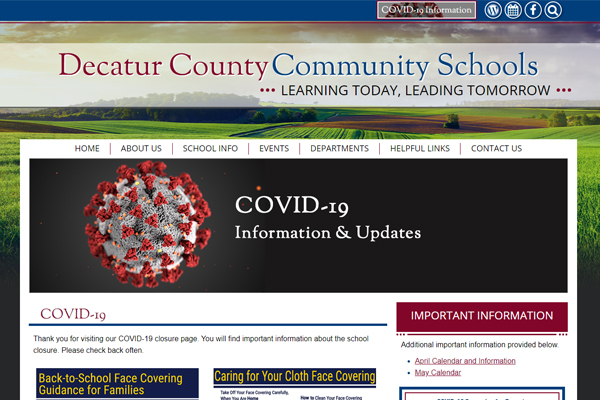
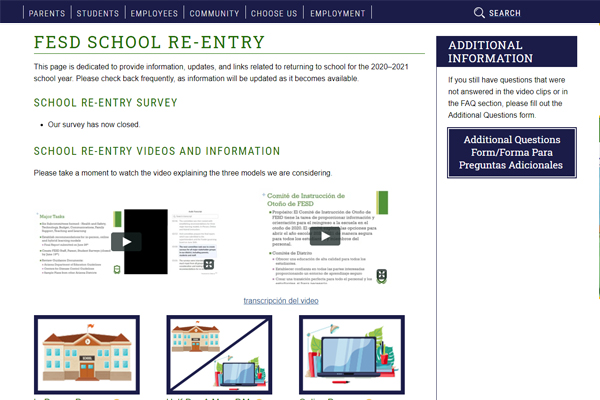
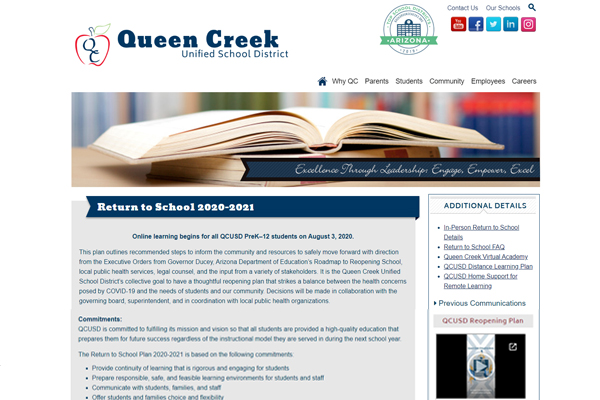
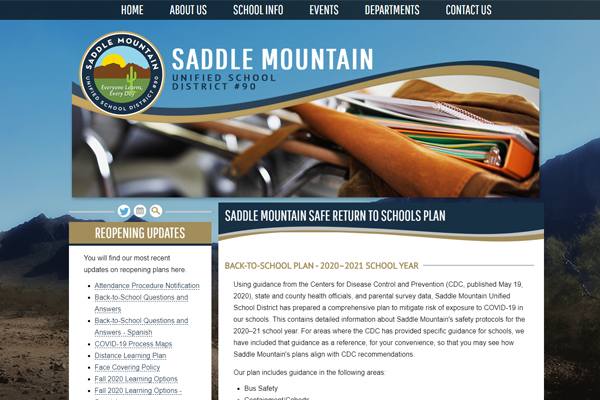
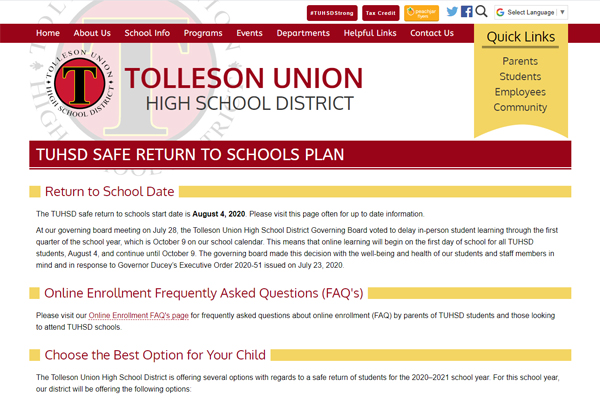

One major public relations tip as your school works to communicate important updates: don’t lose good posts by only updating your emergency message! We know the emergency pop-up message is the best for grabbing the attention of your community. But as soon as the next update comes along, your last message is lost. We recommend keeping a page dedicated to your return to school plan like those examples above or, at least, updating your news page with information parents and your community will need in the long run.
We’re Here to Help
As your school coordinates communications, creates content, and shares that content on your communication channels, your community will be well informed and thankful for your efforts during this difficult time. No solutions will be perfect. But open, honest communication is key to forming a partnership with the parents in your community. You’re in this together; make sure your communication channels are open!
And we’re here to help. Whether you need a communications coordinator to unify your communications teams, a video created, or a website or webpage developed, School Webmasters is ready and willing to assist you with your school communication efforts. Give us a call or send us an email and let us know how we can help.
Katie Brooks, School Webmasters PR Director








